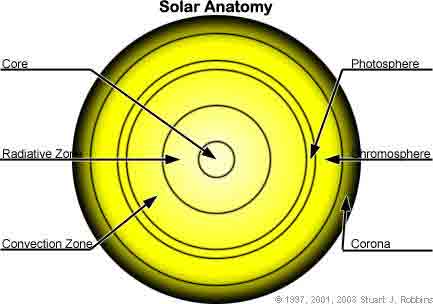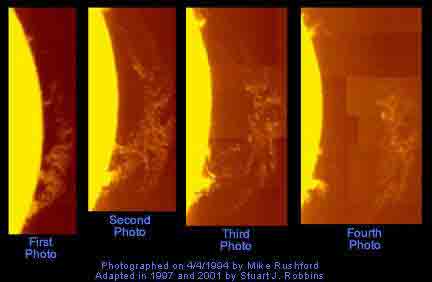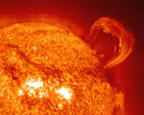|
> The Sun > Mercury > Venus > Earth > Mars > Jupiter > Saturn > Uranus > Neptune > Pluto > Comets
|
The Sun is the star at
the centre of our Solar system. It is occasionally referred to by its
Latin name, Sol, to distinguish it from other "suns". Planet Earth orbits
the Sun, as do many other bodies, including other planets,
asteroids,
meteoroids, comets and dust. Its heat and light support almost all life on
Earth. General InformationThe Sun is classified as a main sequence star, which means
it is in a state of "hydrostatic balance", neither contracting or
expanding, and is generating its energy through nuclear fusion of hydrogen
nuclei into helium. The Sun has a spectral class of G2V, with the G2
meaning that its color is yellow and its spectrum contains spectral lines
of ionized and neutral metals as well as very weak hydrogen lines, and the
V signifying that it, like most stars, is a "dwarf" star on the main
sequence. [Top] StructureThe Sun is a near-perfect sphere, with an oblateness
estimated at about 9 millionths, which means the polar diameter differs
from the equatorial by about 10 km. This is because the centrifugal effect
of the Sun's slow rotation is 18 million times weaker than its surface
gravity (at the equator). Tidal effects from the planets do not
significantly affect the shape of the Sun, although the Sun itself orbits
the center of mass of the solar system, which is offset from the Sun's
center mostly because of the large mass of Jupiter. The mass of the Sun is
so comparatively great that the center of mass of the solar system is
generally within the bounds of the Sun itself. [Top]
At the center of the Sun, where its density reaches up to
150,000 kg/m3 (150 times the density of water on Earth),
thermonuclear reactions (nuclear fusion) convert hydrogen into helium,
producing the energy that keeps the Sun in a state of equilibrium. About
8.9×1037 protons (hydrogen nuclei) are converted to helium
nuclei every second, releasing energy at the matter-energy conversion rate
of 4.26 million tonnes per second or 383 yottawatts (9.15×1016
tons of TNT per second). Models predict that the high-energy photons
released in fusion reactions take about a million years to reach the Sun's
surface, where they escape as visible light. Neutrinos are also released
in the fusion reactions in the core, but unlike photons they very rarely
interact with matter, and so almost all are able to escape the Sun
immediately. [Top]
From about 0.2 to about 0.7 solar radii, the material is hot and dense enough that thermal radiation is sufficient to transfer the intense heat of the core outward. In this zone, there is no thermal convection: while the material grows cooler with altitude, this temperature gradient is not strong enough to drive convection. Heat is transferred by ions of hydrogen and helium emitting photons, which travel a brief distance before being re-absorbed by other ions. [Top]
From about 0.7 solar radii to 1.0 solar radii, the
material in the Sun is not dense enough or hot enough to transfer the heat
energy of the interior outward via radiation. As a result, thermal
convection occurs as thermal columns carry hot material to the surface
(photosphere) of the Sun. Once the material cools off at the surface, it
plunges back downward to the base of the convection zone, to receive more
heat from the top of the radiative zone. Convective overshoot is thought
to occur at the base of the convection zone, carrying turbulent downflows
into the outer layers of the radiative zone. [Top]
The visible surface of the Sun, the photosphere, is the layer below which the Sun becomes opaque to visible light. Above the photosphere, sunlight is free to propagate into space and its energy escapes the Sun entirely. Sunlight has approximately a black-body spectrum that indicates its temperature is about 6,000 K, interspersed with atomic absorption lines from the tenuous layers above the photosphere. The photosphere has a particle density of about 1023/m3 (this is about 1% of the particle density of Earth's atmosphere at sea level). The parts of the Sun above the photosphere are referred to collectively as the solar atmosphere. They can be viewed with telescopes operating across the electromagnetic spectrum, from radio through visible light to gamma rays. [Top]
The coolest layer of the Sun is the temperature minimum region about 500 km above the photosphere. It is about 4,000 K. It is the only part of the Sun cool enough to support simple molecules such as carbon monoxide and water; all other parts of the Sun are hot enough to break chemical bonds. [Top]
Above the visible surface of the Sun is a thin layer, about 2,000 km thick, that is dominated by a spectrum of emission and absorption lines. It is called the chromosphere from the Greek root chromos, meaning color, because the chromosphere is visible as a colored flash at the beginning and end of total eclipses of the Sun. [Top]
The corona is the extended outer atmosphere of the Sun, which is much larger in volume than the Sun itself. The corona merges smoothly with the solar wind that fills the solar system and heliosphere. The low corona, which is very near the surface of the Sun, has a particle density of 1011/m3 (Earth's atmosphere near sea level has a particle density of about 2x1025/m3). The temperature of the corona is several million degrees K. [Top] Theoretical Problems
For some time it was thought that the number of neutrinos produced by the nuclear reactions in the Sun was only a third of the number predicted by theory, a result that was termed the solar neutrino problem. Several neutrino observatories were constructed, including the Sudbury Neutrino Observatory and Kamiokande to try to measure the solar neutrino flux. It has recently been found that neutrinos have rest mass, and can therefore transform into harder-to-detect varieties of neutrinos while en route from the Sun to Earth in a process known as neutrino oscillation. Thus, measurement and theory have been reconciled. [Top]
The optical surface of the Sun (the photosphere) is known
to have a temperature of about 6,000 K. Above it lies the solar corona
with a temperatures of one million degrees. The high temperature of the
corona suggests that it is heated by something other than the photosphere. Currently, it is unclear whether waves are an efficient heating mechanism. All waves except Alfven waves have been found to dissipate or refract before reaching the corona. In addition, Alfven waves do not easily dissipate in the corona. Current research focus has therefore shifted towards flare heating mechanisms. One possible candidate to explain coronal heating is continuous flaring at small scales, but this is still an open topic of investigation. [Top]
Theoretical models of the sun's development suggest that
3.8 to 2.5 billion years ago, during the Archean period, the Sun was only
about 75 percent as bright as it is today. Such a weak star would not have
been able to sustain liquid water on the Earth's surface, and thus life
should not have been able to develop. [Top] Solar Space MissionsTo obtain an uninterrupted view of the Sun, the European
Space Agency and NASA cooperatively launched the Solar and Heliospheric
Observatory (SOHO) on December 2, 1995. [Top] History and Future of SunThe Sun is thought to be a second-generation star, whose
formation may have been triggered by shockwaves from a nearby supernova.
This is suggested by a high abundance of heavy elements such as iron, gold
and uranium in the solar system: the most plausible ways that these
elements could be produced are by endothermic nuclear reactions during a
supernova or by transmutation via neutron absorption inside a massive
first generation star.
|


